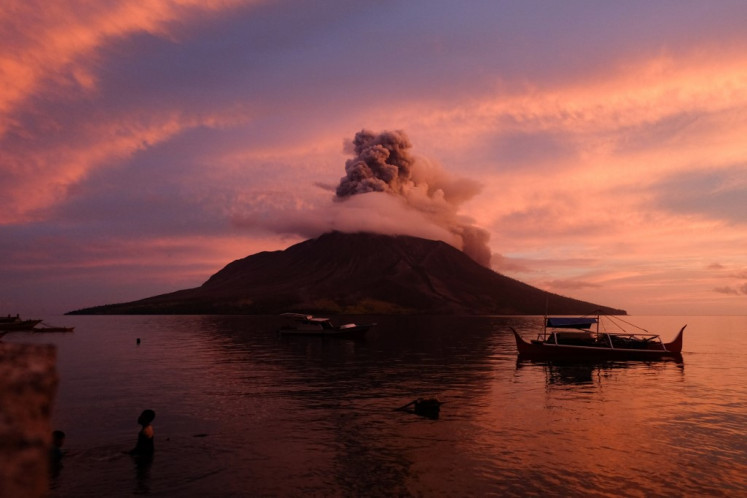Energy and climate change management in Indonesia
Two sectors, energy and forestry, play crucial roles in our efforts to combat global climate change
Change Size

T
wo sectors, energy and forestry, play crucial roles in our efforts to combat global climate change. In the energy sector it is specifically the burning of fossil fuels that leads to the emission of global warming causing carbon dioxide.
Forests meanwhile serve as sinks for the carbon dioxide we produce; the larger the forest, the more carbon emissions it can absorb.
As a member of the global community, what we do in our forestry sector plays a significant role in helping mitigate global climate change. Promoting the REDD (reducing emission from deforestation and degradation) scheme is one way Indonesia can help.
Indonesia's consumption of energy is not as large as that of China or India. Carbon dioxide emissions produced by Indonesia's energy sector are much smaller than those that result from the culling of our forests, especially during forest fire season. But this does not mean that the Indonesia energy sector need not participate in endeavours to combat climate change.
A reduction of carbon dioxide emissions from the energy sector could be implemented by adding clean energy sources to our current energy portfolio (supply side) or by making sure we consume the energy we do use more efficiently (demand side).
The first approach could include developing nuclear power plants or renewable energy sources (particularly geothermal) or by shifting our consumption of fossil fuels from the dirtier sources (coal) to the cleaner ones (natural gas).
The Blue Print for National Energy Management 2005-2025 targets a major shift in the country's energy portfolio, from a heavy reliance on oil to the use of more coal, natural gas and renewable energy. Minimizing the total cost of energy consumption seems to be the objective function of the plan.
However, the major constraint for the implementation of this supply side approach is that it requires a huge amount of capital investment, which Indonesia lacks. Construction of energy infrastructure requires thorough and consistent planning over a relatively long period. We do not currently have such a good long term plan for the development of large-scale, complex energy infrastructure.
We do have a "target" of developing nuclear power plants (stated in the 2005-2025 Long-Term Development Plan) but so far it is not clear how we may meet this target, given that project development for nuclear power plants is a complex endeavour in which we have no experience.
There is an ambitious plan to develop about 4,000 Megawatts of power from geothermal energy (as a part of the second 10,000 Megawatt project), but we have yet to successfully implement the first huge 10,000 Megawatt project. Other renewable projects that might produce lower carbon dioxide emissions await the stronger commitment from various parties, including the government, that are essential for the success of the project.
The conservation (demand side) approach, on the other hand, can be achieved faster and at a lower cost; it also has a larger potential for emission reduction. We might better going in this direction.
Studies across countries, including that by the International Energy Agency, show that energy efficiency and conservation promise much better results in terms of emissions than merely pursuing cleaner energy sources.
The governor of California Arnold Schwarzenegger is among the leaders strongly campaigning for energy conservation to mitigate climate change. He argued the government should force energy consumers (particularly in the transportation sector) to meet energy-emission targets.
In Indonesia we question who has the power to regulate energy consumption. Our energy institutions emphasise the supply side and largely neglect the demand side.
The use of motorbikes, cars, etc. is allowed to grow at an uncheck rate, without considering the amount of energy they are consuming nor the huge amount of pollution they create. Industries in Indonesia meanwhile rely on inefficient and high polluting machinery; concentrated in Java, these industries are far from where our energy sources are located meaning inefficient transportation is also required.
Coal fired plants dominate our electricity mix. The plants continuously release huge amounts of carbon dioxide and other green house gasses (into the western and eastern part of Java in particular).
In general, energy is consumed lavishly as its production, transportation and consumption pollutes our sky and land.
Even though there has been regulation on energy conservation published (Presidential Decree No 10 Year 2005 for example), the institution dealing with the policy is too small and lacks the capacity to effectively make people conserve energy.
There is the hope that the newly-created National Energy Council will have the power to balance our approach to energy management between supply and demand, but we may still have to wait for the Council led by the President to put their policies into effect.
It is not only to mitigate climate change but also to improve our energy intensity that we have to implement broad energy conservation programs. Establishing the old-planning Energy Conservation Center and preparing the Law on Rational Use of Energy are things we should wait longer to start work on.









